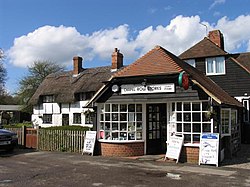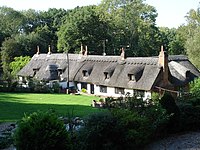Chapel Row: Difference between revisions
Created page with '{{Infobox town |name=Chapel Row |county=Berkshire |picture=Chapel Row Post Office and Stores - geograph.org.uk - 1504.jpg |picture caption=Chapel Row Post Office |os grid ref=SU5…' |
No edit summary |
||
| Line 14: | Line 14: | ||
|constituency=West Berkshire | |constituency=West Berkshire | ||
}} | }} | ||
'''Chapel Row''' is a small village in [[Berkshire]], and part of the civil parish of [[Bucklebury]]. It | '''Chapel Row''' is a small village in [[Berkshire]], and part of the civil parish of [[Bucklebury]]. It lies near the A4 road, just five and a half miles northeast of [[Newbury]]. | ||
Chapel Row has been often in the news as the home of Catherine, Duchess of Cambridge before her marriage to Prince William in April 2011. | Chapel Row has been often in the news as the home of Catherine, Duchess of Cambridge before her marriage to Prince William in April 2011. | ||
Latest revision as of 17:44, 6 August 2014
| Chapel Row | |
| Berkshire | |
|---|---|
 Chapel Row Post Office | |
| Location | |
| Grid reference: | SU572695 |
| Location: | 51°25’18"N, 1°10’47"W |
| Data | |
| Post town: | Newbury |
| Postcode: | RG7 |
| Dialling code: | 0118 |
| Local Government | |
| Council: | West Berkshire |
| Parliamentary constituency: |
West Berkshire |
Chapel Row is a small village in Berkshire, and part of the civil parish of Bucklebury. It lies near the A4 road, just five and a half miles northeast of Newbury.
Chapel Row has been often in the news as the home of Catherine, Duchess of Cambridge before her marriage to Prince William in April 2011.
Since the mid 17th century, an inn has stood near to the village green. The site is now occupied by The Bladebone Inn.
The Chapel Row Fayre
In the 18th century, Chapel Row became known for its revels, which were held on the Monday following the feast day of Saint Anne.[1] The revels featured events such as backswording (described by Joseph Addison in The Spectator as "a ring of cudgel players who broke one another's heads in order to make some impression on their mistresses' hearts").[1] The sport was not featured in a number of later fayres as at least one contender was reported to have been killed.[1]
An 1812 Reading Mercury article on the fayre focuses primarily on agriculture, stating that the event was an opportunity to trade cattle and employ farmhands.[2]

Outside links
| ("Wikimedia Commons" has material about Chapel Row) |
References
- Ford, D N (2001a), Bucklebury, Wokingham, Berkshire: Royal Berkshire History, http://www.berkshirehistory.com/villages/bucklebury.html
- Ford, D N (2001b), The Chapel Row Revel, Wokingham, Berkshire: Royal Berkshire History, http://www.berkshirehistory.com/articles/chapel_row_revel.html
- The Chapel Row Fayre (2010), The History of the Fayre, http://www.chapelrowfayre.co.uk/history.html
